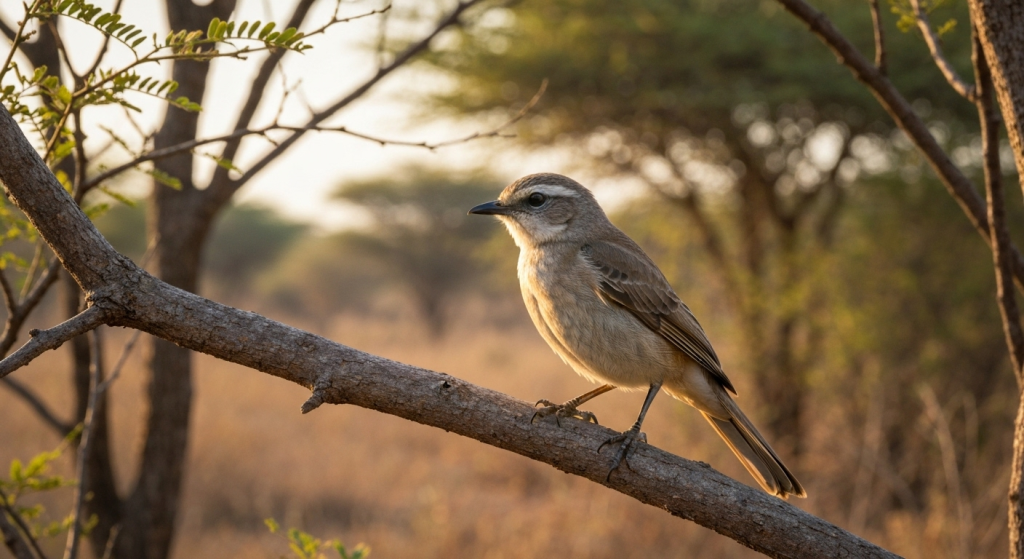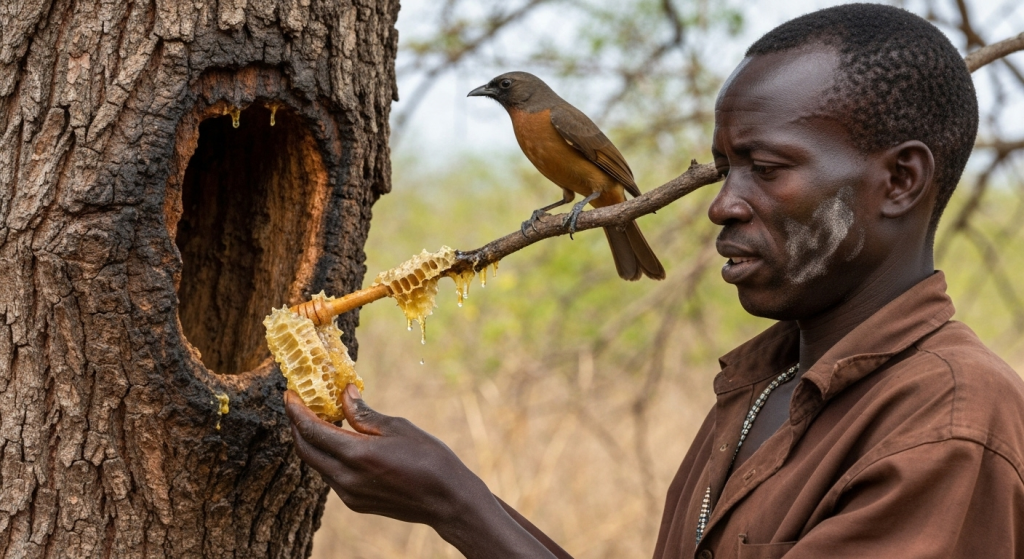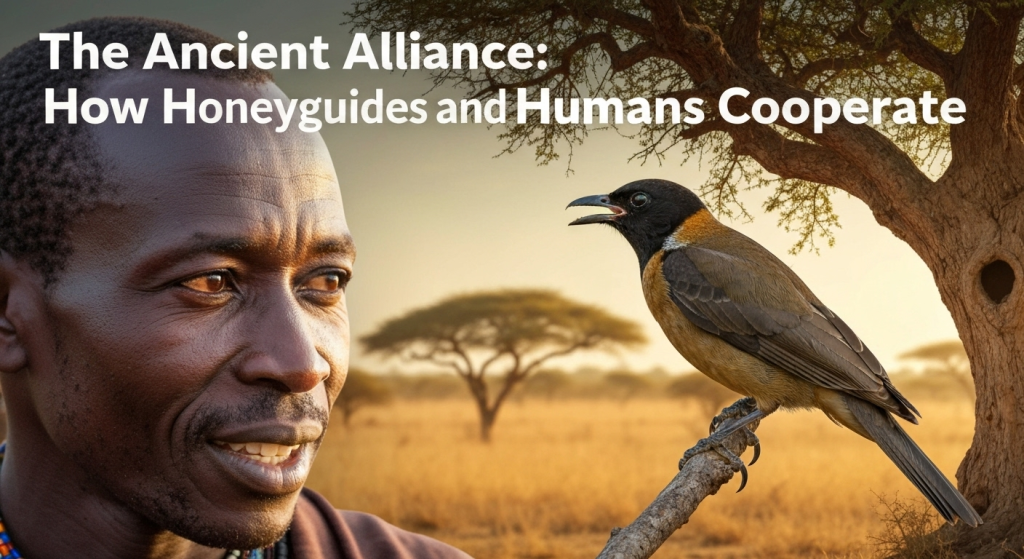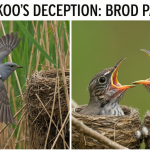Have you ever heard a story from the natural world that sounds more like a fable than a fact? The idea of two entirely different species—a small, wild bird and a human—actively working together for a common goal is one of those tales. Yet, in the woodlands of Africa, this incredible partnership is a real, living tradition. The Greater Honeyguide, a bird with an insatiable appetite for beeswax, has learned to communicate with humans, guiding them to hidden beehives. This isn’t just a bird getting lucky; it’s a deliberate, two-way conversation that has been refined over thousands of years. It’s one of the most remarkable examples of mutualism between our species and another.
As someone who has spent years exploring the intricate lives of birds, I’m Mahnoor Farooq, and the relationship between humans and honeyguides has always captivated me. It challenges our understanding of animal intelligence and interspecies communication. My work often involves digging into scientific research and cultural stories to understand not just what birds do, but why they do it. The honeyguide partnership isn’t just a quirky behavior; it’s a story of trust, co-evolution, and a shared language that bridges the gap between two very different worlds. It’s a powerful reminder that we are far more connected to the ecosystems around us than we often realize.
Understanding the Star of the Show: The Greater Honeyguide

Before we dive into the details of this partnership, let’s get to know the bird itself. The Greater Honeyguide (Indicator indicator) is a relatively plain-looking bird, about the size of a sparrow, found across much of sub-Saharan Africa. You wouldn’t necessarily notice it in a crowd of more colorful birds. But its unremarkable appearance hides an extraordinary set of behaviors and a highly specialized diet that makes its alliance with humans not just helpful, but essential for its survival.
A Unique and Demanding Diet
The key to this entire relationship lies in the honeyguide’s diet. Unlike most birds, the Greater Honeyguide has a unique ability to digest beeswax. Beeswax is a tough, complex substance that is indigestible to most animals. However, honeyguides have specialized gut bacteria that allow them to break it down and extract nutrients. While they also eat bee larvae and insects, beeswax is a critical, high-energy food source for them.
Here’s the problem: a honeyguide is a small bird. A wild beehive, often hidden in the hollow of a baobab tree or a rock crevice, is a formidable fortress. It’s guarded by thousands of stinging bees, and the wax is deep inside. The bird simply cannot access the hive on its own. It lacks the strength to break open the hive and the ability to withstand a full-scale bee attack. This is where humans enter the story.
The Mechanics of a Two-Way Conversation

This isn’t just a case of a clever human following a bird. It’s a genuine, interactive process where both parties communicate and understand each other’s roles. From my experience studying animal behavior, this level of intentional, cooperative communication between a wild animal and a human is exceedingly rare. It’s a system of calls, responses, and rewards built on generations of trust.
The Honeyguide’s Guiding Call
The process begins with the honeyguide. When a bird has located a beehive, it actively seeks out a human partner. It flies to a nearby village or trail and begins its specific guiding call—a persistent, chattering sound. It’s not a song; it’s a signal. The bird will make short flights, perching on branches and chattering insistently, waiting for a human to notice and respond.
Once a person acknowledges the bird, the hunt is on. The honeyguide leads the way, flying from tree to tree, always staying just ahead of its human follower. The bird monitors the human’s progress, waiting for them if they fall behind. As they get closer to the nest, the bird’s behavior changes:
- Shorter Flights: The flights between perches become shorter.
- Lower Perches: The bird begins to perch on lower branches.
- Call Changes: The chattering call may change in pitch or frequency, indicating that the target is near.
- Circling: Finally, upon reaching the tree with the hive, the bird will often circle the location and then fall silent, its job as a guide complete.
The Human’s Role: The Essential Response
This partnership would fail if humans didn’t know how to “speak” back. Traditional honey-hunters, like the Yao people of Mozambique and the Hadza of Tanzania, have developed specific calls to communicate with the birds. The most well-documented is a loud, trilling sound, often described as “brrrr-hm.”
This isn’t just a random noise. Scientific research has shown that honeyguides are far more likely to initiate and continue guiding when they hear this specific sound. Why?
- It Signals an Expert Partner: The call tells the bird that the person is a knowledgeable honey-hunter who understands the rules of the partnership.
- It Confirms Engagement: It lets the bird know that the human is actively following and paying attention.
- It Increases Success: Studies led by Dr. Claire Spottiswoode confirmed that using the traditional “brrrr-hm” call more than doubled the probability of being successfully guided to a beehive.
Once the hive is located, the human’s most important job is to subdue the bees, typically using smoke from a smoldering bundle of sticks. This drives the bees away, allowing safe access to the honey and, most importantly for the bird, the wax. After harvesting the liquid honey, the honey-hunter always leaves a generous portion of the wax-filled honeycomb for the guide as a reward. This reward is crucial, as it reinforces the bird’s behavior and ensures it will guide again in the future.
Mutualism in Action: A Win-Win Scenario
In ecology, this type of relationship is called mutualism, where two species benefit from interacting with each other. The honeyguide-human partnership is a textbook example. Let’s break down the clear advantages for each side.
| For the Greater Honeyguide | For the Human Honey-Hunter |
| Access to Food: Gains access to its primary food source—beeswax and larvae—which it cannot get on its own. | Finds a Hidden Resource: Locates beehives far more efficiently and quickly than through searching alone. |
| Safety: Avoids the danger of bee stings by letting humans handle the most hazardous part of the job. | Increased Success Rate: Research shows that honey-hunting with a guide is significantly more successful than without one. |
| Energy Conservation: Expends less energy searching for a partner who can open the hive than trying to find an already-exposed nest. | Cultural and Economic Value: Honey provides a vital source of calories and can be a valuable commodity for trade. |
This isn’t a one-sided deal. The birds drastically reduce the search time for honey-hunters. The Hadza people, for instance, estimate that over 80% of their successful hive finds are thanks to the help of a honeyguide. Without the bird, finding enough honey to be a worthwhile food source would be incredibly difficult. This relationship is woven into the very fabric of their culture and survival.
A Fragile Tradition in a Modern World
Despite being one of the most enduring examples of human-animal cooperation, this ancient partnership is now facing serious threats. The cultural knowledge required for this “conversation” is fading in many communities as lifestyles change.
Why is the Partnership Disappearing?
- Loss of Traditional Knowledge: As younger generations move to cities or adopt different lifestyles, the specific calls and skills needed for honey-hunting are not always passed down. If humans stop responding, the birds will eventually stop guiding.
- Availability of Sugar: The widespread availability of cheap, processed sugar has reduced the reliance on honey as a primary sweetener. This lessens the incentive for people to undertake the difficult and sometimes dangerous task of honey-hunting.
- Habitat Loss and Deforestation: As woodlands are cleared for agriculture and development, both honeyguides and the bees they depend on lose their homes. Fewer trees mean fewer places for bees to build hives.
- Negative Perceptions: In some areas, honeyguides have gained a reputation as pests. There are also myths and legends that paint them as tricksters who might lead people to predators instead of honey (though there is no scientific evidence for this).
The disappearance of this tradition is more than just the loss of a fascinating behavior. It represents a disconnect between humans and their local environment. This partnership is a living piece of human heritage and a powerful symbol of a time when survival depended on a deep understanding of and cooperation with the natural world. Conservation efforts are not just about protecting the bird; they are about preserving the cultural knowledge that makes this interaction possible.
Final Thoughts: A Lesson in Listening
Spending time in the field, you learn that nature is full of conversations. Most of the time, we are not part of them. We are just observers. The honeyguide and the honey-hunter offer a rare exception—a glimpse into a world where the line between observer and participant blurs. It’s a powerful lesson in listening. The Yao and Hadza people learned to listen to the bird, and in doing so, they forged an alliance that has benefited both species for centuries.
This partnership teaches us that cooperation can be a powerful evolutionary force. It shows that communication doesn’t require a shared spoken language, but rather a shared understanding of needs and rewards. As we continue to navigate our own relationship with the natural world, the story of the honeyguide is a vital reminder that partnership is not only possible, but it can also be the key to mutual survival and success.
Frequently Asked Questions (FAQs)
Is the Greater Honeyguide the only bird that does this?
While the Greater Honeyguide is the most famous and well-studied, some other species in the Indicator genus are also known to guide animals, including other birds and honey badgers, to beehives. However, the partnership with humans is the most complex and well-documented.
Do honeyguides ever lead people to dangerous animals?
This is a common myth, but there is no scientific evidence to support it. The bird’s survival depends on getting its reward of beeswax. Leading a human partner to a predator would be counterproductive and would not benefit the bird in any way. The goal is always the beehive.
What happens if the human doesn’t leave a reward for the bird?
Failing to reward the honeyguide is considered a serious breach of trust. It is believed that a bird that is not rewarded will be less likely to guide that person, or perhaps anyone, in the future. The entire system is built on the bird’s expectation of a reward for its effort.
How do young honeyguides learn to cooperate with humans?
This is an area of ongoing research. It is believed to be a combination of instinct and learned behavior. Young birds likely learn by observing experienced adult guides and associating the specific human calls with a successful hunt and a wax reward. Similarly, young honey-hunters learn the calls and techniques from their elders.
Conclusion
The collaboration between honeyguides and humans is a stunning example of what is possible when two species learn to communicate and trust one another. It’s a relationship born from mutual need and sustained by mutual benefit. More than just an ecological curiosity, it is a testament to the deep, intricate connections that can form within an ecosystem. As this tradition faces the pressures of the modern world, its story serves as a crucial reminder of the profound wisdom embedded in ancient practices and the immense value of listening to the voices of the wild.


